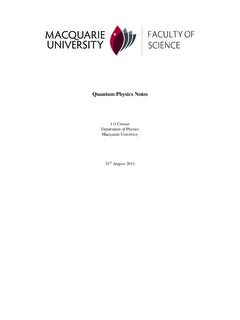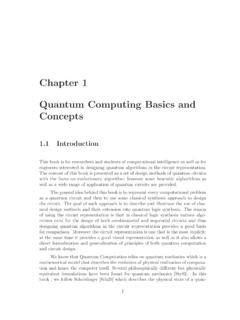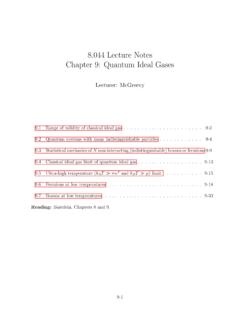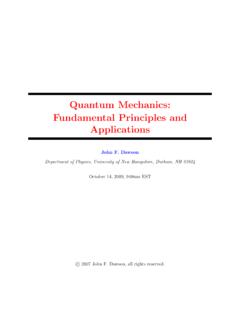Transcription of 3. Angular Momentum States. - Columbia University
1 3. Angular Momentum States. We now employ the vector model to enumerate the possible number of spin Angular Momentum states for several commonly encountered situations in photochemistry. We shall give examples for the important situations involving the coupling of several electron spins, since these examples will capture the most important features of cases commonly observed in photochemical sytems. Of these the most important is the coupling of two electron spins with one another. After deducing the number of states that result from coupling of individual spins, we shall be interested in the relative energy ranking of these spin states when magnetic interactions and couplings are present.
2 These interactions and couplings will be connected to molecular structure through the relationship of spin Angular Momentum and magnetic moments due to spin. The coupling of magnetic moment due to spin with other magnetic moments will be the basis for the understanding of both magnetic resonance spectroscopy and intersystem crossing. For magnetic resonance spectroscopy, the influence of an applied laboratory magnetic field on the energy levels is of particular importance. For intersystem crossing, couplings of the electron spin with other sources of Angular Momentum are important. Before counting Angular Momentum states for the important commonly encountered cases, we shall briefly review the principles of both classical Angular Momentum and quantum Angular Momentum and relate these quantities to the vector model.
3 Classical Angular Momentum . The Physics of Rotational Motion. Classical Angular Momentum refers to the rotation motion of of an object around a fixed point or about a fixed axis. The two most important models of Angular Momentum for chemistry are (1) a particle constrained to move in a circular path with a fixed radius about a point (Figure 4, left) and (2) a spherical body rotating about a fixed axis that passes through a point at the center of the sphere (Figure 4, right). These two simple models capture the essence of the origin of electron orbital Angular Momentum and to electron spin Angular Momentum . We choose two definite physical models to visualize (1) orbital Angular Momentum in terms of an electron of mass me travelling in a circular Bohr orbit or radius r with Angular velocity v, and (2) spin Angular Momentum in terms of a spherical top or gyroscope spinning about an axis with a moment of inertia, I, and an Angular velocity, v (the moment of inertia is related to a radius of gyration, r, rotating about the center of mass).
4 Let the orbital Angular Momentum be symbolized by L and the spin Angular Momentum of a single 3. Angular Momentum States. July 27, 1999. electron be symbolized by S. According to classical mechanics the values of L. and S are given by equations 1 and 2, respectively. L = mvr (1). S = Iv (2). According to classical mechanics, both the orbital and spin Angular Momentum of a particle undergoing circular motion (as an electron in a Bohr orbit) or a rotating top or gyroscope (as an electron spinning on its axis) may be represented as a vector. To visualize this vector we employ the "right hand thumb rule" which states the Angular Momentum vector points in the direction that a right-hand thumb points when the fingers of the right hand are turned in the same sense as the rotation.
5 Figure 4 shows the vector representation of the orbital Angular Momentum of an electron, L, in a Bohr orbit and of the spin Angular Momentum , S, of a single electron spinning on its axis. From classical mechanics, the direction of the Angular Momentum vector is always perpendicular to the plane defined by the circular motion of the electron in its orbit or the rotation of the spherical electric charge. The length of the vector represents the magnitude of the Angular Momentum . The important features of the classical representation of Angular Momentum are: (1) that Angular Momentum can be represented by a vector whose direction is related to the sense of the direction of rotation; (2) that the representation of the vector can be conveniently placed on the axis of rotation; and (3) that the length of the vector is proportional to the absolute magnitude of the Angular Momentum .
6 In these diagrams the vector sizes are generally schematic and not to scale. orbitral Angular spin Angular Momentum vector,L Momentum vector, S. L. S. v r v Figure 4. Classical representation of the Angular Momentum of an electron in a Bohr orbit (left) and of an electron spinning about an axis (right). The important features to note are the Angular Momentum in both cases possesses a characteristic circular motion: in one case the mass of the particle is at a distance, 3. Angular Momentum States. July 27, 1999. r, from the axis of rotation, and in the other case the center of mass is at a distance, r, from the axis of rotation. quantum Electron Spin Angular Momentum The results of classical Angular Momentum provide a clear physical model for representation of orbital and spin Angular Momentum in terms of the vector model.
7 Let us now consider the new features that are introduced by the laws of quantum mechanics which spin Angular Momentum (both electronic and nuclear) must obey. The elementary components of an atom (electrons and protons) behave as if they were spinning on an axis. The motion of the electron spin (or a nuclear spin) can be considered to be a "zero point" motion. It is eternal and cannot be stopped. The spinning electron is like a ltoy top that is simultaneously provided with a pulse of rotational energy and magically freed from friction or other means of dissipating the rotational energy. Thus, the magnitude of an electron spin is fixed and constant in time and cannot be changed.
8 These qualities are all subsumed in the statement that an electron possesses exactly 1/2\ worth of spin Angular Momentum . Recall that \ is Planck's constant divided by 2 . The factor 2 is a natural consequence of the circular motion implicit in all forms of Angular Momentum . No matter where the electron resides, in bonds with a partner of opposite spin orientation, as an entity in a half occupied orbital, as a member of a cluster of spins of the same orientation, or in orbitals of different Angular Momentum (s, p, d, etc.), the spin of the individual electron is always 1/2\ exactly. We shall see that the fact that the proton, 13C and other nuclei also possess exactly 1/2 \ of spin Angular Momentum will allow them to couple with electron spins and thereby be actively involved in magnetic resonance and intersystem crossing.
9 This coupling will allow the conservation of Angular Momentum to be maintained as Angular Momentum is exchanged between the coupled partners. The situation will be completely analogous to maintaining conservtion of energy while energy is being exchanged between coupled partners. According to the laws of classical mechanics the Angular Momentum of a rotqting body may assume any value or any direction of the Angular Momentum , consistent with torques applied to the body. This means that in a Cartesian coordinate system, the Angular Momentum of a body around each of the three perpendicular axes may take any value consistent with the magnitude of the Angular Momentum .
10 Thus, if electron spin were a classical quantity, the magnitude and direction of the vector representing the spin Angular Momentum could assume any length, S, and any angle relative to the z-axis. The situation is quite different for a quantum mechanical particle, such as an electron or a proton. In the quantum case the amount of Angular Momentum is quantized 3. Angular Momentum States. July 27, 1999. and can achieve only certain definite values for any given value of the Angular Momentum . This means that only certain orientations of the Angular Momentum can occur in physical space. This in turn implies that only certain orientations of the spin Angular Momentum vector are allowed in spin space.
















